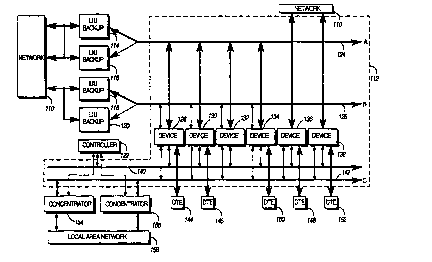Une partie des informations de ce site Web a été fournie par des sources externes. Le gouvernement du Canada n'assume aucune responsabilité concernant la précision, l'actualité ou la fiabilité des informations fournies par les sources externes. Les utilisateurs qui désirent employer cette information devraient consulter directement la source des informations. Le contenu fourni par les sources externes n'est pas assujetti aux exigences sur les langues officielles, la protection des renseignements personnels et l'accessibilité.
L'apparition de différences dans le texte et l'image des Revendications et de l'Abrégé dépend du moment auquel le document est publié. Les textes des Revendications et de l'Abrégé sont affichés :
| (12) Demande de brevet: | (11) CA 2171456 |
|---|---|
| (54) Titre français: | ARCHITECTURE DE SYSTEME DE COMMUNICATION EVOLUEE |
| (54) Titre anglais: | ADVANCED COMMUNICATION SYSTEM ARCHITECTURE |
| Statut: | Réputée abandonnée et au-delà du délai pour le rétablissement - en attente de la réponse à l’avis de communication rejetée |
| (51) Classification internationale des brevets (CIB): |
|
|---|---|
| (72) Inventeurs : |
|
| (73) Titulaires : |
|
| (71) Demandeurs : | |
| (74) Agent: | GOWLING WLG (CANADA) LLP |
| (74) Co-agent: | |
| (45) Délivré: | |
| (86) Date de dépôt PCT: | 1995-06-28 |
| (87) Mise à la disponibilité du public: | 1996-02-15 |
| Requête d'examen: | 1996-03-08 |
| Licence disponible: | S.O. |
| Cédé au domaine public: | S.O. |
| (25) Langue des documents déposés: | Anglais |
| Traité de coopération en matière de brevets (PCT): | Oui |
|---|---|
| (86) Numéro de la demande PCT: | PCT/US1995/008112 |
| (87) Numéro de publication internationale PCT: | WO 1996004763 |
| (85) Entrée nationale: | 1996-03-08 |
| (30) Données de priorité de la demande: | ||||||
|---|---|---|---|---|---|---|
|
L'invention concerne un système de communication permettant de coupler une pluralité de terminaux de transmission de données (144, 146, 148, 10, 152) à un réseau téléphonique. Ce système comporte un bus d'accès (124) de réseau téléphonique à multiplexage par répartition dans le temps ayant une pluralité de voies temporelles contenant des données, couplé au réseau téléphonique (110). Il comporte également un bus d'accès aux terminaux numériques couplé aux dispositifs de communication (128, 130, 132, 134, 136, 138), chaque dispositif pouvant être configuré pour accéder à n'importe quelle voie temporelle. Un contrôleur (122) assure la configuration de chaque dispositif de communication lui permettant d'accéder à une voie temporelle.
A communication system for coupling a plurality of data terminals (144, 146, 148, 10, 152) to a telephone network has a time division
multiplexed telephone network access bus (124), providing a plurality of time division slots containing data, coupled to the telephone
network (110), and a digital terminal access bus coupled to the plurality of communication devices (128, 130, 132, 134, 136, 138), each
communication device being configurable to access any of the time division slots. A controller (122) configures each communication device
to access a time division slot.
Note : Les revendications sont présentées dans la langue officielle dans laquelle elles ont été soumises.
Note : Les descriptions sont présentées dans la langue officielle dans laquelle elles ont été soumises.

2024-08-01 : Dans le cadre de la transition vers les Brevets de nouvelle génération (BNG), la base de données sur les brevets canadiens (BDBC) contient désormais un Historique d'événement plus détaillé, qui reproduit le Journal des événements de notre nouvelle solution interne.
Veuillez noter que les événements débutant par « Inactive : » se réfèrent à des événements qui ne sont plus utilisés dans notre nouvelle solution interne.
Pour une meilleure compréhension de l'état de la demande ou brevet qui figure sur cette page, la rubrique Mise en garde , et les descriptions de Brevet , Historique d'événement , Taxes périodiques et Historique des paiements devraient être consultées.
| Description | Date |
|---|---|
| Inactive : CIB expirée | 2022-01-01 |
| Inactive : CIB du SCB | 2022-01-01 |
| Inactive : CIB de MCD | 2006-03-12 |
| Inactive : CIB de MCD | 2006-03-12 |
| Inactive : CIB de MCD | 2006-03-12 |
| Inactive : CIB de MCD | 2006-03-12 |
| Inactive : CIB de MCD | 2006-03-12 |
| Inactive : CIB de MCD | 2006-03-12 |
| Le délai pour l'annulation est expiré | 1998-06-29 |
| Demande non rétablie avant l'échéance | 1998-06-29 |
| Réputée abandonnée - omission de répondre à un avis sur les taxes pour le maintien en état | 1997-06-30 |
| Exigences pour une requête d'examen - jugée conforme | 1996-03-08 |
| Toutes les exigences pour l'examen - jugée conforme | 1996-03-08 |
| Demande publiée (accessible au public) | 1996-02-15 |
| Date d'abandonnement | Raison | Date de rétablissement |
|---|---|---|
| 1997-06-30 |
Les titulaires actuels et antérieures au dossier sont affichés en ordre alphabétique.
| Titulaires actuels au dossier |
|---|
| MOTOROLA, INC. |
| Titulaires antérieures au dossier |
|---|
| CHARLES E., JR. POLK |
| DAVID EARL WILDER |
| DAVID PAUL NELSON |
| STEVEN R. BLACKWELL |